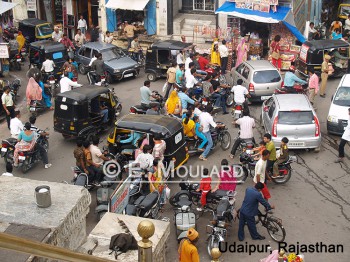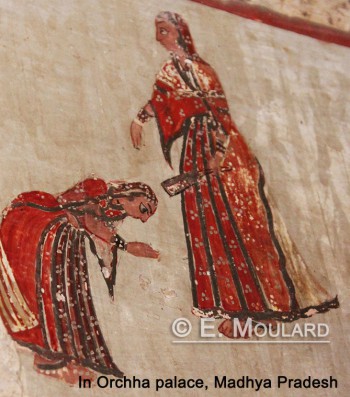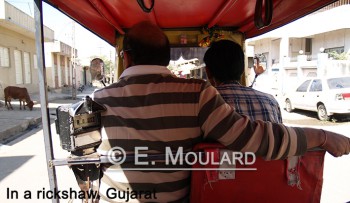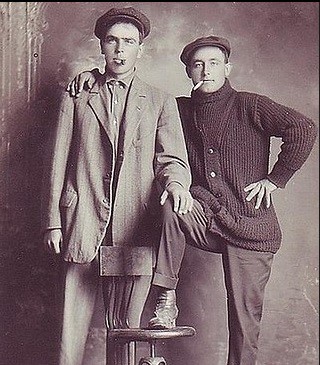10/20/2013
Why in India it's the jungle on the roads?
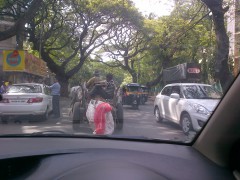 I drove my four colleagues to the restaurant the other day. One of them appreciated my driving style by passing the following comment: “If a cop stopped you he would immediately give you the Indian nationality!” Understand that, in ten minutes, I had honked enough and went through enough red lights to be called an Indian!
I drove my four colleagues to the restaurant the other day. One of them appreciated my driving style by passing the following comment: “If a cop stopped you he would immediately give you the Indian nationality!” Understand that, in ten minutes, I had honked enough and went through enough red lights to be called an Indian!
But then, why do Indians drive so bad?
I stop you immediately, it is not because of women! In 2011, only 11% of the driving licenses belonged to women (1); and most of them don’t even drive...
It's a combination of factors that explains the anarchy that reigns on the roads in India...
There are not enough roads (even if the road network is the second worldwide in terms of kilometres and increases from 4% per year since 1951) (2); and especially they are horrible! And I am not talking about the roads of Madhya Pradesh (where it takes 10 hours to cover 500 kms); Mumbai (the economic capital) asphalt has more holes than the gruyère!
The number of drivers increases super-fast, a few dozen millions every year.
And the practice of driving is relatively new: in one generation (20 years) the number of vehicles on the roads has gone up from 5 to 142 million! And yet... barely 1% of Indians own a car. (3) Scary! (except perhaps for the automakers...)
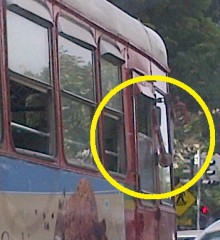 Most people use public transport (90% of it being the bus) or auto-rickshaws. But bus drivers are the mentally challenged: they do not stop under any circumstance (not even to load passengers). Mumbai bus drivers even operate manually their turning signal – a steel arrow placed on the front windows. When they operate it. Most the vehicles date back to Methuselah and they often carry 2 to 3 times the number of scheduled passengers. Hence tens of thousands of victims of the public transport in India every year... (4)
Most people use public transport (90% of it being the bus) or auto-rickshaws. But bus drivers are the mentally challenged: they do not stop under any circumstance (not even to load passengers). Mumbai bus drivers even operate manually their turning signal – a steel arrow placed on the front windows. When they operate it. Most the vehicles date back to Methuselah and they often carry 2 to 3 times the number of scheduled passengers. Hence tens of thousands of victims of the public transport in India every year... (4)
To top it off, most Indians got their license in a lucky bag or somethin! Technically, when you apply, they give you a temporary license and to get the final license you have to pass a driving test (driving lessons are not compulsory however). I did a round table and three of my four colleagues have not given the exam... You can buy everything in India! As a result, most Indians seem to ignore the difference between high and low beam headlights and you can get totally blinded when you drive at night in a city (especially in Delhi)...
I found an online test to check if you know the driving ; thereregulations are only a dozen simple questions (5). I did it, and then I went on to search for the driving rules in India (6). There are just 30: keep left; drive on the left side when planning to turn left; drive on the right side when planning to turn right; pass to the right (unless the vehicle before you has stopped to turn right); slow down when arriving at an intersection or a crosswalk, when entering a road interjection, if the road entered is a main road designated as such, give way to the vehicles proceeding along the road, and in any other case give way to all traffic approaching to the intersection on his right hand; do not u-turn when it is prohibited; stop for pedestrians; give free passage to ambulances; do no drive a vehicle in a reverse direction into a road designated ‘One Way’; stop at the signal and the police officer who controls traffic. And that’s pretty much it!
simple questions (5). I did it, and then I went on to search for the driving rules in India (6). There are just 30: keep left; drive on the left side when planning to turn left; drive on the right side when planning to turn right; pass to the right (unless the vehicle before you has stopped to turn right); slow down when arriving at an intersection or a crosswalk, when entering a road interjection, if the road entered is a main road designated as such, give way to the vehicles proceeding along the road, and in any other case give way to all traffic approaching to the intersection on his right hand; do not u-turn when it is prohibited; stop for pedestrians; give free passage to ambulances; do no drive a vehicle in a reverse direction into a road designated ‘One Way’; stop at the signal and the police officer who controls traffic. And that’s pretty much it!
Except on it comes to signals! Judge by yourself: "When about to slow down, extend the right arm with the palm downward; when about to stop, raise the right forearm vertically outside, palm to the right; when about to turn to the right, extend the right hand in a horizontal position outside with the palm of the hand turned to the front; when about to turn to the left, extend the right arm and rotate it in an anticlockwise direction; when about to overtake, extend the right hand and arm horizontally outside and bring the arm backward and forward in a semi- circular motion. The signals referred above may be simplified also by mechanical or electrical devices."
To conclude, the most important rule (which is not written) is: look straight and drive! The others will manage to avoid you, no problem...
Let us not forget the hyper-individualistic behaviour of Indians in certain circumstances (apparently inherited from the time of protectionism, rationing and shortages, where the Indians had to fight, literally, to have access to any consumption good (food, radio, clothes etc.). Behaviour you can come across when waiting in a line or… driving!
And above all I would like to highlight that cars are not the only ones who have the right to use the roads... Cows, goats, bullock-carts, tractors, horses also have a right of way.
Mix all that and you get chaos on the roads! And obviously there are a lot of accidents and many more lethal ones that one might imagine given the slow speed of driving... (7)
(1) Source: http://articles.timesofindia.indiatimes.com/2012-03-08/chennai/31135711_1_women-friendly-licences-motorcycle-manufacturers
(2) If the India has the second road network in the world with 4.2 million kilometers which grows 4% annually since 1951 (3.4% since 2001), it's still a growth over half the number of cars. Source: http://www.indiaspend.com/investigations/indias-traffic-n...
(3) 0.3 million vehicles in 1951, 5.4 million in 1981, 21.4 million in 1991, 55 million in 2001 and 142 million in 2011!
Sources: http://nctr.USF.edu/JPT/PDF/JPT%208-1%20Singh.PDF http://data.gov.in/dataset/state-wise-total-registered-mo...
Review of Urban Transportation in India: http://nctr.USF.edu/JPT/PDF/JPT%208-1%20Singh.PDF
The Indian fleet is almost five times that of France (with 142 million vehicles on Indian roads in 2011 against 31 million in France). Obviously if reported number of inhabitants the France has 4 times more vehicles per 1,000 inhabitants (481 against 118).
Sources: http://www.statistiques-mondiales.com/ue_voitures.htm; http://www.knowindia.NET/auto.html ; http://www.linternaute.com/auto/magazine/l-automobile-en-10-CHIFFRES-CLES/31-millions.shtml
(4) The bus represents 90% of public transportation in India – a trend shared all across the country except in Mumbai where trains carry 58% of the people who use public transport. In Delhi and Chennai less than half the people use public transportation. A trend opposed to Mumbai or Kolkata – which is due to the configuration of the cities (the first ones are less densely populated, more polycentric and geographically spread). The Delhi metro is superb but already crowded (especially at peak hours) and not practical: its star structure requires to always go back to the heart of the city to change lines. Bangalore and Kolkata also have the metro and it is under process in many other cities.
Sources: http://cistup.IISc.ernet.in/urban%20Mobility%208th%20March%202012/crisis%20Of%20public%20transport%20in%20India.PDF ; http://economictimes.Indiatimes.com/slideshows/infrastructure/ten-metro-rail-projects-transforming-Indian-cities/Kochi-Metro/slideshow/21478253.CMS
(5) http://rtoindia.com/startTest.asp
(6) http://auto.indiamart.com/user-manual/road-regulation.html
(7) http://www.indiansamourai.com/archive/2009/08/18/-.html
08:00 Posted in Why in India... | Permalink | Comments (0) | Tags: india, traffic, driving, highway code, rules, car, bus, public transportation, driving left, permitted, metro, road network, accidents, road, street, cows, goats, rickshaws | ![]() Facebook | |
Facebook | |
10/18/2013
Why in India they touch the feet of their elders?
Be careful where you put your feet in India!
For instance, when you are sitting, you must not point your feet towards others, especially if they are old.
Or, one of the worst insults you can do to a Hindu is to throw a shoe in his face (I just found that out and find it good to know!). Walking on a guy while trying to climb onto a train berth also works quite also... (this I have tested for you! At the same time I am not sure any of my compatriots would like it too much either!)
In fact, when a Hindu touches your foot or shoe by accident, he makes a weird gesture (reaching out to your foot and then to his heart or his chin): his way to apologize. A question of education. Like when some people apologize after sneezing...
Morality: guys, avoid playing footsie under the table with a girl to hit on her!
You must remove your shoes at the temple (always) and in houses (in general). It’s quite an easy operation because many Indians wear open shoes, which also reduces foot odors...
And what about foot mycosis? I remember how I laughed when a French friend got shit scared of catching some because he was forced to walk in the puddles in flip-flops (monsoon obliges). I had never thought of it! What makes me laugh even more is discovering, by doing some research, right now, I learn that the foot fungus and other dermatophytes, are a major health problem in tropical countries like India, with sometimes risks of epidemic. When I think about the floor of that temple filled of rat piss and rain water! At the same time it is not so much of a surprise when you think about all the stray dogs with scabies. Or about all these people delousing each other on the sidewalks. But no need to panic: I never caught any mycosis in seven years!
If you want to shock an Indian you can put your feet on a book, a journal, a computer, a piece of paper. It is just like if you stamped on the goddess of knowledge, Saraswati, who is embodied in all these objects. You may be wondering how one ends up with his feet on a book but when you study very late every night, you often end up instinctively with your feet on your desk as it eases blood circulation.
Similarly apparently Hindus should not blow on fire. Yeah it would be like blowing on the face of the God of fire, Agni. Not very polite is it?? That said I have seen many people blowing birthday candles!
The feet symbolism dates back to the Vedic time (the Vedas being texts of the fifteenth century BC) where the universe was the body of the God: there was a top and a bottom. The pure and the impure. Feet are at the bottom and therefore unclean, impure.
Any rule has an exception. Obviously. When it comes to feet, the exception is the feet of the gods, the spiritual leaders and the elders which are not dirty. So it's not gross to touch them; it is even a sign of respect. It is a gesture made on many occasions: a departure or return from traveling, a wedding, a festival, a religious ceremony etc. In the old times children had to touch the feet of their parents when going to bed and getting up.
My ex-favorite Indian had explained to me that in the Kerala tradition the eldest brother of the bride had to wash the feet of the groom, as a sign of respect.
When you bend to touch the feet of an elderly person he usually doesn’t let you finish your gesture and replies by touching your forehead and blessing you with wishes of long life, prosperity and wealth.
This custom seems to be very very old since it is mentioned in the Mahabharata (an epic that is not dated but probably more than two thousand years old) where it is written “touching the feet of the mother, father, teachers and elders with devotion and serving them until they are content and give their blessing, is what makes a person great and strong”.
It does not really explain the origin of the gesture. But I found an explanation I quite like. When you do yoga you are taught some notions of energy circulation. It is thus thought that by touching the feet of others we absorb their energy and in turn by placing their hand on our forehead they allow the energy to move from the hand to the head.
Sources : http://scholarsresearchlibrary.com/ABR-vol2-iss3/ABR-2011-2-3-88-93.pdf;
http://www.iloveindia.com/indian-traditions/touching-feet.html; http://www.window2india.com/cms/admin/article.jsp?aid=5991; http://www.volunteeringinindia.org/etiquette-and-customs.htm; http://www.sanskrit.org/www/Hindu%20Primer/feetsymbolism.html
08:00 Posted in Why in India... | Permalink | Comments (0) | Tags: india, feet, touching feet, customs, fungal infection, dermatophyte, traditions, energy, mycosis, respect | ![]() Facebook | |
Facebook | |
10/16/2013
Why in India men hold hands?
Foreigners are always shocked to see Indian men strolling two by two, hand in hand... And even if I am used to it, seeing my new hired casually leave his hand on the thigh of a colleague he met the same morning, then lie back comfortably and pass his arm over the shoulders of the other guy, it still felt weird.
It is all the more surprising that men don’t behave like this with women at all…
So the first thing that comes to mind is that India explodes the ratios of homosexuality... But actually no, they are in the norm (1) (with admittedly a little more guys having ‘circumstantial’ homosexual sex since premarital sex is still a taboo – they do with whatever hole they get before they get married!). It was even considered an offence until 2010, when the Supreme Court observed that live-in relationships and premarital sex was nothing illegal (2). Until then, I remember that some hotels did not let us sleep together, my ex-favorite Indian and I, because we were not married and that the police could come down and arrest us for prostitution...
Similarly, the law does not specifically prohibit public displays of affection: the Penal Code of 1860 stipulates that “whoever, to the annoyance of others, does any obscene act in any public place, shall be punished with imprisonment of either description for a term which may extend to three months, or with fine, or with both” (3). But there is nowhere a definition of obscenity... (4).
The fact that it is legal doesn’t mean that it is morally well-accepted (5). It is even quite condemned... And the mentalities are changing, but not very fast... For example, more and more young people lose their virginity before marriage but they are forced to have sex in parks or on building roofs since it is out of question to bring someone of the opposite gender to your room...
Indians have a particular concept of ‘vital space’: it simply doesn’t mean anything. How many have I had a neighbour on a plane invading my space by overflowing the armrest? How many Indians sit on the lap of strangers in overcrowded buses or trains and it doesn’t bother anyone? How many families sleep six or more in a single room? Go try explaining the concept of ‘vital space’ in overpopulated cities... And what good would it do to them anyway?
And to make it simple, they like human contact. Period.
And if you look well, it’s been only a few decades than Western males no longer have much physical contact. This phenomenon would be linked to the rise of homophobia.
At the end of the nineteenth century, homosexuality began to emerge as an identity rather than just a practice: it evolved from something you would do (through the sexual act) to something you would be (a homosexual). Gradually homosexuals attracted more and more suspicion which culminated in a witch-hunt in the 1950s. And the more threatening homosexuals appeared the more that male bodies drifted apart: straight guys wanted to make sure that no one would believe they were gay. “The paranoia had replaced public affection.” (6)
Photo: www.artofmanliness.com
(1) http://www.indiansamourai.com/search/homosexualit%C3%A9
(3) Section 294 (a) of the Indian Penal Code, 1860
(4) The word 'obscene' has not been defined in the code. The laws are vague in that no. specific definition is laid down which could lead to arbitrary interpretation and in gross violation of freedom of expression enshrined in the Constitution of India
08:00 Posted in Why in India... | Permalink | Comments (0) | Tags: india, sex, public display of affection, pda, kiss, hug, vital space, homosexuality, holding hands | ![]() Facebook | |
Facebook | |















